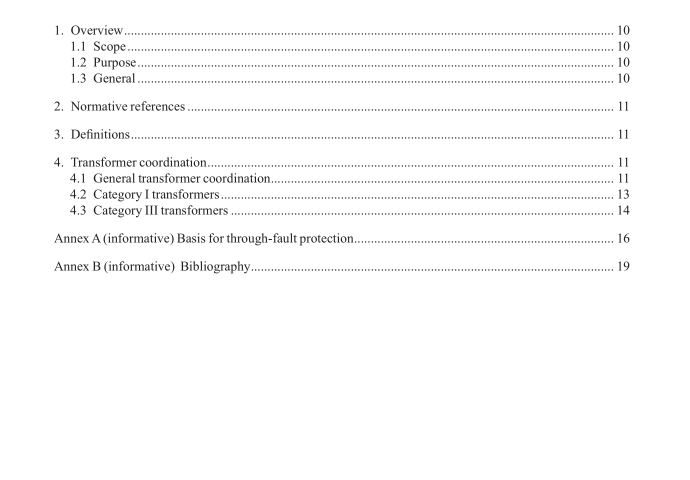IEEE C57.12.59-2015 pdf download.IEEE Guide for Dry-Type Transformer Through-Fault Current Duration
1.1 Scope
This guide for dry-type transformer through-fault current duration applies to dry-type distribution and power transformers built in accordance with IEEE Std C57.12.01™.
1.2 Purpose
This guide sets forth recommendations believed essential for the application of overcurrent protective devices that limit the exposure time of dry-type transformers to short-circuit currents. This guide is not intended to imply overload capability.
1.3 General
Protective devices, such as relays and fuses, have well-defi ned operating characteristics that relate fault mag- nitude to clearing time. It is desirable that these characteristic curves be coordinated with comparable curves applicable to dry-type transformers that relate duration and fault magnitude to withstand capability.
The magnitude and duration of fault currents are of utmost importance in establishing a coordinated protection practice for transformers, as both mechanical and thermal effects of fault currents shall be considered. For fault-current magnitudes near the maximum short-circuit current rating of the transformer, mechanical effects are more signifi cant than thermal effects.
The maximum symmetrical short-circuit current should not exceed 25 times normal base current in accordance with IEEE Std C57.12.01. At lower fault-current magnitudes ap- proaching the overload range, mechanical effects are less important unless the frequency and duration of fault occurrence is high enough to promote mechanical degradation. The point of transition between mechanical concern and thermal concern cannot be precisely defned; mechanical effects tend to have a more prominent role in larger kVA ratings because the mechanical forces are greater.
2. Normative references
The following referenced documents are indispensable for the application of this document (i.e., they must be understood and used, so each referenced document is cited in text and its relationship to this document is explained).
For dated references, only the edition cited applies. For undated references, the latest edition of the referenced document (including any amendments or corrigenda) applies. IEEE Std C37.91™, IEEE Guide for Protective Relay Applications to Power Transformers. 2,
IEEE Std C57.12.01™, IEEE Standard General Requirements for Dry-Type Distribution and Power Transformers.
3. Defnitions For the purposes of this document, the following terms and defnitions apply. The IEEE Standards Dictionary Online should be consulted for terms not defned in this clause.
4 normal base current: Rated current of a transformer corresponding to its rated voltage and rated base kVA. short-circuit impedance: the sum of transformer impedance and system short-circuit impedance at the trans- former location, expressed in percent of rated voltage and rated base kVA of the transformer. transformer short-circuit impedance: the transformer impedance expressed in percent of rated voltage and rated base kVA of the transformer.
4. Transformer coordination
4.1 General transformer coordination For the purposes of coordination of overcurrent protective devices, with transformer short-circuit withstand capability, Figure 1, Figure 2, and Figure 3 are presented as protection curves for transformer Categories I through III as defned in IEEE Std C57.12.01 and adopted in Table 1.
For Category I, a single curve applies that re ects both thermal and mechanical damage considerations. For Categories II and III, two curves apply, one of which re ects both thermal and mechanical damage considerations, while the other re? ects primarily thermal damage considerations only. On curves that have both a solid and dotted portion, the solid portion represents a total fault duration beyond which thermal damage to insulation adjacent to current-carrying conductors and anneal-softening of aluminum may occur, while the dotted portion represents a total fault duration beyond which cumulative mechanical damage may occur. The increasing signi cance of mechanical effects for higher kVA transformers is re ected in these curves. The frequency of faults varies with different transformer applications. Applications characterizing frequent and infrequent faults are presented in the annex of IEEE Std C37.91.IEEE C57.12.59 pdf download.IEEE C57.12.59-2015 pdf download
IEEE C57.12.59-2015 pdf download

Leave a Reply